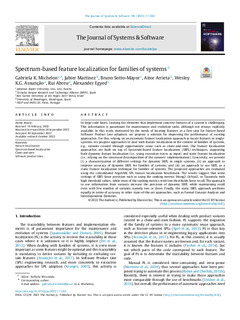| dc.rights.license | Attribution 4.0 International | * |
| dc.contributor.author | Arrieta, Aitor | |
| dc.contributor.other | Michelon, G.K. | |
| dc.contributor.other | Martinez, Jabier | |
| dc.contributor.other | Sotto-Mayor, B. | |
| dc.contributor.other | Assunção, W.K.G. | |
| dc.contributor.other | Abreu, R. | |
| dc.contributor.other | Egyed, Alexander | |
| dc.date.accessioned | 2023-01-12T12:06:12Z | |
| dc.date.available | 2023-01-12T12:06:12Z | |
| dc.date.issued | 2022 | |
| dc.identifier.issn | 1873-1228 | en |
| dc.identifier.other | https://katalogoa.mondragon.edu/janium-bin/janium_login_opac.pl?find&ficha_no=170553 | en |
| dc.identifier.uri | https://hdl.handle.net/20.500.11984/5942 | |
| dc.description.abstract | In large code bases, locating the elements that implement concrete features of a system is challenging. This information is paramount for maintenance and evolution tasks, although not always explicitly available. In this work, motivated by the needs of locating features as a first step for feature-based Software Product Line adoption, we propose a solution for improving the performance of existing approaches. For this, relying on an automatic feature localization approach to locate features in single-systems, we propose approaches to deal with feature localization in the context of families of systems, e.g., variants created through opportunistic reuse such as clone-and-own. Our feature localization approaches are built on top of Spectrum-based feature localization (SBFL) techniques, supporting both dynamic feature localization (i.e., using execution traces as input) and static feature localization (i.e., relying on the structural decomposition of the variants’ implementation). Concretely, we provide (i) a characterization of different settings for dynamic SBFL in single systems, (ii) an approach to improve accuracy of dynamic SBFL for families of systems, and (iii) an approach to use SBFL as a static feature localization technique for families of systems. The proposed approaches are evaluated using the consolidated ArgoUML SPL feature localization benchmark. The results suggest that some settings of SBFL favor precision such as using the ranking metrics Wong2, Ochiai2, or Tarantula with high threshold values, while most of the ranking metrics with low thresholds favor recall. The approach to use information from variants increase the precision of dynamic SBFL while maintaining recall even with few number of variants, namely two or three. Finally, the static SBFL approach performs equally in terms of accuracy to other state-of-the-art approaches, such as Formal Concept Analysis and Interdependent Elements. | en |
| dc.description.sponsorship | Gobierno Vasco-Eusko Jaurlaritza | es |
| dc.language.iso | eng | en |
| dc.publisher | Elsevier | en |
| dc.rights | © 2022 The Authors | en |
| dc.rights.uri | http://creativecommons.org/licenses/by/4.0/ | * |
| dc.subject | Feature localization | en |
| dc.subject | Spectrum-based localization | en |
| dc.subject | Clone-and-own | en |
| dc.subject | Software product lines | en |
| dc.title | Spectrum-based feature localization for families of systems | en |
| dcterms.accessRights | http://purl.org/coar/access_right/c_abf2 | en |
| dcterms.source | Journal of Systems and Software | en |
| local.contributor.group | Ingeniería del software y sistemas | es |
| local.description.peerreviewed | true | en |
| local.identifier.doi | https://doi.org/10.1016/j.jss.2022.111532 | en |
| local.relation.projectID | info:eu-repo/grantAgreement/GV/Ikertalde Convocatoria 2022-2023/IT1519-22/CAPV/Ingeniería de Software y Sistemas/ | en |
| local.contributor.otherinstitution | https://ror.org/052r2xn60 | en |
| local.contributor.otherinstitution | https://ror.org/02fv8hj62 | es |
| local.contributor.otherinstitution | https://ror.org/05tkyf982 | en |
| local.contributor.otherinstitution | https://ror.org/043pwc612 | pt |
| local.source.details | Vol. 195. N. artículo 111532. January, 2022 | en |
| oaire.format.mimetype | application/pdf | |
| oaire.file | $DSPACE\assetstore | |
| oaire.resourceType | http://purl.org/coar/resource_type/c_6501 | en |
| oaire.version | http://purl.org/coar/version/c_ab4af688f83e57aa | en |








